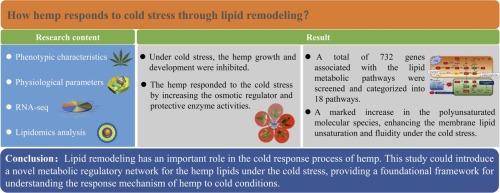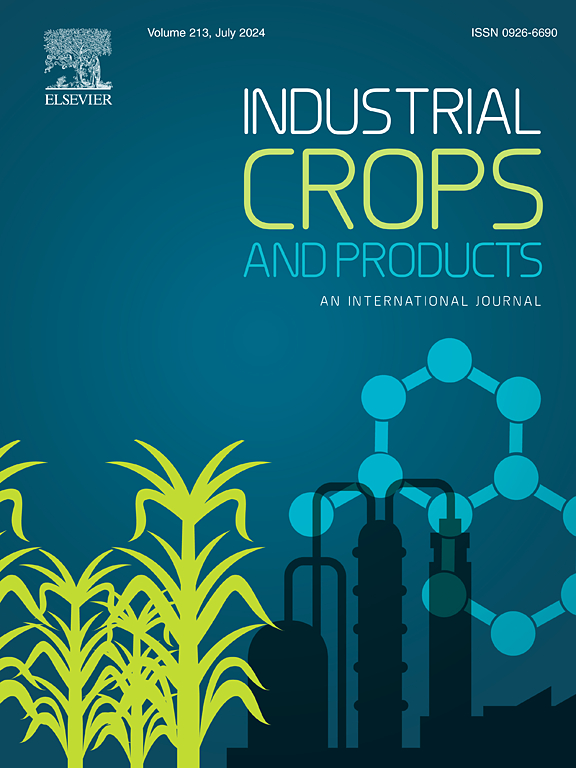Lipidomic remodeling in Cannabis sativa L. under cold tolerance
IF 5.6
1区 农林科学
Q1 AGRICULTURAL ENGINEERING
引用次数: 0
Abstract
In order to explore the lipidomic remodeling mechanisms and biological basis of hemp response to cold stress, the physiological and biochemical indices of hemp were analyzed, and a regulatory network for lipid metabolism under cold stress (4 ℃) was constructed. The results revealed that cold stress, inhibited the growth and development of hemp, with the total fresh weight decreasing by 29∼37 %, and the total dry weight decreasing by 17∼22 %. Additionally, the photosynthesis system was damaged, prompting plants to produce osmotic regulators and activate protective enzymes. Lipidomic analysis revealed that galactolipids, including MGDG, DGDG, and SQDG, were the dominant membrane lipids in hemp leaves, accounting for 70 % of the total membrane lipid components. Notably, some lipid remodeling was observed in hemp leaf tissue 3 d after cold stress treatment. Specifically, higher PC/PE and DGDG/MGDG ratios, along with a 53 % increase in PA levels, highlighted the critical role of membrane lipid remodeling and fatty acid unsaturation in hemp adaptation to cold stress. The transcriptomic analysis revealed that the lipid metabolism pathways were activated, with 732 genes associated with lipid metabolic pathways were identified. These genes were primarily enriched in the pathways related to TAG synthesis, fatty acid metabolism, and membrane lipid metabolism. A novel metabolic regulatory network for hemp lipids under cold stress was constructed, offering some insights into the molecular events underlying changes in membrane lipids during cold stress and identifies the key lipids and pathways responsible for resilience to such stress, thereby facilitating the development of new approaches for crop tolerance to stress.

耐寒条件下大麻脂质组学的重塑
为了探索大麻对冷胁迫响应的脂质体重塑机制和生物学基础,分析了大麻的生理生化指标,构建了冷胁迫(4 ℃)下脂质代谢调控网络。结果表明,冷胁迫抑制了大麻的生长发育,总鲜重减少了29∼37 %,总干重减少了17∼22 %。此外,光合作用系统受到破坏,促使植物产生渗透调节剂并激活保护酶。脂质体分析表明,半乳糖脂(包括 MGDG、DGDG 和 SQDG)是大麻叶片中最主要的膜脂,占总膜脂成分的 70%。值得注意的是,在冷胁迫处理 3 d 后,大麻叶片组织中出现了一些脂质重塑现象。具体而言,PC/PE和DGDG/MGDG比率升高,PA水平增加了53%,这突显了膜脂重塑和脂肪酸不饱和在大麻适应冷胁迫过程中的关键作用。转录组分析表明,脂质代谢途径被激活,共鉴定出 732 个与脂质代谢途径相关的基因。这些基因主要富集在与 TAG 合成、脂肪酸代谢和膜脂代谢相关的通路中。该研究构建了寒冷胁迫下大麻脂质的新型代谢调控网络,对寒冷胁迫期间膜脂质变化的分子事件有了一定的了解,并确定了对这种胁迫具有抗逆性的关键脂质和通路,从而促进了作物抗逆新方法的开发。
本文章由计算机程序翻译,如有差异,请以英文原文为准。
求助全文
约1分钟内获得全文
求助全文
来源期刊

Industrial Crops and Products
农林科学-农业工程
CiteScore
9.50
自引率
8.50%
发文量
1518
审稿时长
43 days
期刊介绍:
Industrial Crops and Products is an International Journal publishing academic and industrial research on industrial (defined as non-food/non-feed) crops and products. Papers concern both crop-oriented and bio-based materials from crops-oriented research, and should be of interest to an international audience, hypothesis driven, and where comparisons are made statistics performed.
 求助内容:
求助内容: 应助结果提醒方式:
应助结果提醒方式:


